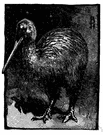ratite
(redirected from Ratites)Also found in: Thesaurus, Medical, Encyclopedia.
Related to Ratites: Struthioniformes
rat·ite
(răt′īt′)adj.
Relating to or being any of a group of flightless birds having a flat breastbone without the keellike prominence characteristic of most flying birds.
n.
A ratite bird, such as the ostrich or emu.
[From Latin ratītus, marked with the figure of a raft (in reference to the lack of the keellike prominence), from ratis, raft.]
American Heritage® Dictionary of the English Language, Fifth Edition. Copyright © 2016 by Houghton Mifflin Harcourt Publishing Company. Published by Houghton Mifflin Harcourt Publishing Company. All rights reserved.
ratite
(ˈrætaɪt)adj
1. (Zoology) (of flightless birds) having a breastbone that lacks a keel for the attachment of flight muscles
2. (Zoology) of or denoting the flightless birds, formerly classified as a group (the Ratitae), that have a flat breastbone, feathers lacking vanes, and reduced wings
n
3. (Animals) a bird, such as an ostrich, kiwi, or rhea, that belongs to this group; a flightless bird
4. (Zoology) a bird, such as an ostrich, kiwi, or rhea, that belongs to this group; a flightless bird
[C19: from Latin ratis raft]
Collins English Dictionary – Complete and Unabridged, 12th Edition 2014 © HarperCollins Publishers 1991, 1994, 1998, 2000, 2003, 2006, 2007, 2009, 2011, 2014
rat•ite
(ˈræt aɪt)adj.
1. having a flat, unkeeled sternum, as an ostrich, cassowary, emu, or moa.
n. 2. a bird having a ratite sternum.
[1875–80; < Latin rat(is) raft + -ite2]
Random House Kernerman Webster's College Dictionary, © 2010 K Dictionaries Ltd. Copyright 2005, 1997, 1991 by Random House, Inc. All rights reserved.
ThesaurusAntonymsRelated WordsSynonymsLegend:
Switch to new thesaurus
| Noun | 1. |  ratite - flightless birds having flat breastbones lacking a keel for attachment of flight muscles: ostriches; cassowaries; emus; moas; rheas; kiwis; elephant birds ratite - flightless birds having flat breastbones lacking a keel for attachment of flight muscles: ostriches; cassowaries; emus; moas; rheas; kiwis; elephant birdsbird - warm-blooded egg-laying vertebrates characterized by feathers and forelimbs modified as wings Struthio camelus, ostrich - fast-running African flightless bird with two-toed feet; largest living bird cassowary - large black flightless bird of Australia and New Guinea having a horny head crest Dromaius novaehollandiae, Emu novaehollandiae, emu - large Australian flightless bird similar to the ostrich but smaller apteryx, kiwi - nocturnal flightless bird of New Zealand having a long neck and stout legs; only surviving representative of the order Apterygiformes Rhea americana, rhea - larger of two tall fast-running flightless birds similar to ostriches but three-toed; found from Brazil to Patagonia nandu, Pterocnemia pennata, rhea - smaller of two tall fast-running flightless birds similar to ostriches but three-toed; found from Peru to Strait of Magellan aepyornis, elephant bird - huge (to 9 ft.) extinct flightless bird of Madagascar moa - extinct flightless bird of New Zealand carinate, carinate bird, flying bird - birds having keeled breastbones for attachment of flight muscles |
Based on WordNet 3.0, Farlex clipart collection. © 2003-2012 Princeton University, Farlex Inc.